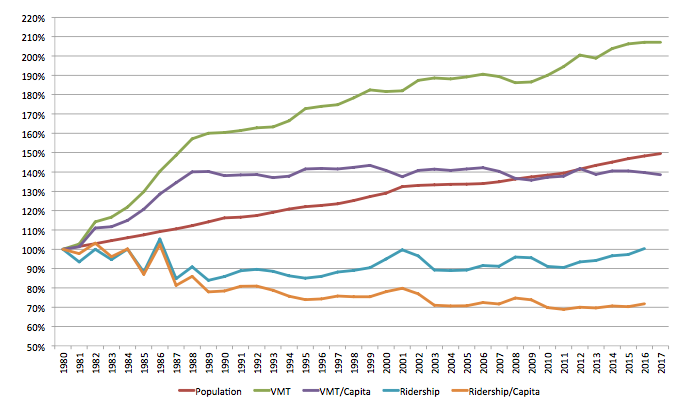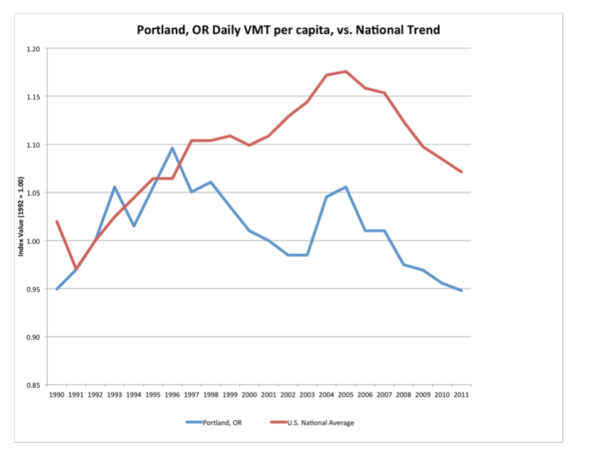TRANSDEF is clear that suburbanization is no longer a viable strategy for growth in the Bay Area. It stopped “working” long ago. Unfortunately, the public and its elected leaders have not yet recognized this alarming fact. TRANSDEF believes that the simultaneous problems of global warming, rising oil and energy prices, and congestion require a strikingly different approach to transportation planning: one that relies on cost-effective transit, Smart Growth walkable/bikeable communities and higher priced driving, to create incentives to use alternative means of transport.
MTC’s continuing focus on expanding highway capacity wastes scarce resources and facilitates more driving, which releases more greenhouse gases, thus exacerbating global warming. Perhaps more immediately, it does nothing to reduce congestion, once the initial respite is over. We need instead to transition to a future where transit is the preferred way to travel longer distances.
MTC has a long-standing commitment to pursuing BART extensions because of their political popularity, despite their tremendous cost. TRANSDEF views this as a rejection of the basic principles of planning, which call for identifying the problem and serving it in the most cost-effective manner possible.
TRANSDEF has determined that the region’s biggest transportation planning problems are:
1). Congestion on I-580 and I-80 resulting from commuters driving in from the Central Valley and Sacramento.
2). The BART Transbay Tube is operating near its capacity.
TRANSDEF believes the most rational use of resources would be to design the Bay Area’s future rail extensions to provide multiple services: High-Speed Rail, interregional commuting, and regional commuting, all using the same compatible infrastructure.
Instead, BART-worship has severely distorted MTC’s transportation priorities. MTC has thrown its support behind proposals to build extremely expensive duplicative infrastructure projects: High-Speed Rail via the Pacheco Pass, a BART extension to San Jose, and the cynical promise of improvements to the ACE corridor (which can’t possibly be funded, due to the cost of the other projects). Meanwhile, MTC shifted funding for the Dumbarton Rail project over to the BART Warm Springs extension, thereby indefinitely delaying the most cost-effective new Transbay crossing.
Judging MTC’s Performance
In 1989, MTC was successfully sued by the Sierra Club and Communities for a Better Environment for failing to do enough to improve the Bay Area’s air quality. To fulfill the court order resulting from that suit, MTC adopted a set of Transportation Control Measures (TCMs) as its method of reducing air pollution. Under the federal Clean Air Act, these measures must be enforceable commitments. One of them, TCM 2, committed to increasing regional transit ridership by 15% over 1982 levels.
In 2001, seeing that transit ridership had increased less than 1% despite a 30% population increase (more than a 21% per capita decrease!), TRANSDEF initiated a lawsuit to enforce the provisions of TCM 2. It was joined by the Sierra Club, Communities for a Better Environment, Latino Issues Forum, Our Children’s Earth Foundation, Urban Habitat and the Bayview Hunters Point Community Advocates. EarthJustice took on the extensive litigation, and won two excellent trial court decisions and an attorney’s fee of $1.1 million.
MTC took the case up on appeal and lucked out with the assignment of judges, getting a very conservative George W. Bush appointee. Two judges ruled that an enforceable commitment (the very heart of Clean Air Act implementation) was not enforceable, while the third judge of the three judge panel supported the trial court decision, as written. A petition to have the case reconsidered by an 11 member panel was denied.
The Complaint
The Opening Brief
The Reply Brief
The Trial Court Decision on MTC’s Liability
The Trial Court Decision on Injunctive Relief
The 9th Circuit Appellate Decision
This litigation almost succeeded in forcing MTC to actually produce increases in transit ridership. MTC narrowly ducked that bullet. Did they learn anything from the experience? Sadly, no…
MTC considers itself one of the nation’s leading metropolitan planning organizations, and possibly the most advanced of them all. Nearly 20 years after the TCM 2 litigation, after a 150% increase in Bay Area population over 1980 levels, transit ridership has recovered to 1982 levels, after a long period of decline. After spending many billions of dollars on BART extensions and highway widenings, regional transit ridership on a per capita basis is an astonishing 30% lower. This is why MTC never looks back to evaluate its performance.
Data from MTC’s Statistical Summary of Bay Area Transit Operators and Bay Area Census reports

Absent powerful intervention like the TCM 2 litigation, MTC will continue allocating funding to its favored projects. While it mouths platitudes about increasing transit use as cover for its funding of BART extensions, the chart above demonstrates that MTC is utterly uninterested in delivering on-the-ground performance results. MTC is a massively failed institution.

Note on the chart to the left how Portland significantly out-performed the national average. Knowing the innovations that Portland introduced back then, this is clearly the result of competent policy implementation. (1992 was chosen as the base year for comparison, because the daily VMT per capita was very similar: 19.80 for Portland and 20.20 nationally.)